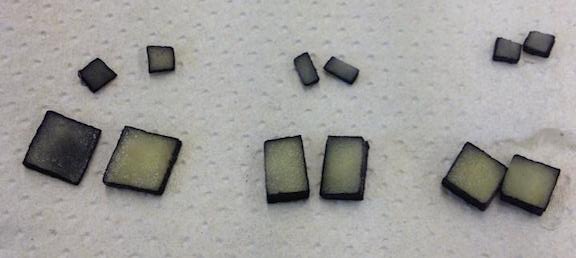Purpose
The purpose of the Inquiries is to allow students to independently test the results of the Investigations by designing their own procedures. While they are variations of the procedures followed in the Investigations, their purpose remains the same.
The purpose of Procedure 1 is to investigate the relationship between cell size and diffusion rate. The purpose of Procedure 2 is to compare diffusive behavior in four different solutions (sucrose, salt, glucose, and albumin) using a fifth, water, as control. The purpose of Procedure 3 is to observe osmosis in actual living cells following the artificial exploration of diffusion and osmosis in Procedures 1 and 2.
Lesson
The experiment demonstrates that surface area to volume ratio is inversely proportional to size, which explains that the small form cells have evolved corresponds to the functional need for efficient diffusion. In diffusion, solutes move from an area of high concentration to an area of low concentration, which requires no energy input from the cell. The diffusion of water is called osmosis.
Solutes decrease the concentration of free water since water molecules surround the solute molecules. A hypertonic solution has a higher solute concentration and lower water potential than the interior of the cell, so water will move into the hypertonic solution through the semipermeable membrane through osmosis. In an isotonic solution, there is no net diffusion since the concentration of solute is equal on both sides of the cell membrane. A hypotonic solution has a lower solute concentration and higher water potential than the interior of the cell, so water will diffuse into the cell. Plant cells are turgid (firm) in hypotonic solutions, flaccid (limp) in isotonic solutions, and plasmolyzed (shriveled) in hypertonic solutions.
Artifact
The purpose of the Inquiries is to allow students to independently test the results of the Investigations by designing their own procedures. While they are variations of the procedures followed in the Investigations, their purpose remains the same.
The purpose of Procedure 1 is to investigate the relationship between cell size and diffusion rate. The purpose of Procedure 2 is to compare diffusive behavior in four different solutions (sucrose, salt, glucose, and albumin) using a fifth, water, as control. The purpose of Procedure 3 is to observe osmosis in actual living cells following the artificial exploration of diffusion and osmosis in Procedures 1 and 2.
Lesson
The experiment demonstrates that surface area to volume ratio is inversely proportional to size, which explains that the small form cells have evolved corresponds to the functional need for efficient diffusion. In diffusion, solutes move from an area of high concentration to an area of low concentration, which requires no energy input from the cell. The diffusion of water is called osmosis.
Solutes decrease the concentration of free water since water molecules surround the solute molecules. A hypertonic solution has a higher solute concentration and lower water potential than the interior of the cell, so water will move into the hypertonic solution through the semipermeable membrane through osmosis. In an isotonic solution, there is no net diffusion since the concentration of solute is equal on both sides of the cell membrane. A hypotonic solution has a lower solute concentration and higher water potential than the interior of the cell, so water will diffuse into the cell. Plant cells are turgid (firm) in hypotonic solutions, flaccid (limp) in isotonic solutions, and plasmolyzed (shriveled) in hypertonic solutions.
Artifact
Lab Report
| diffusionosmosisinquirieslabreport.pdf |

